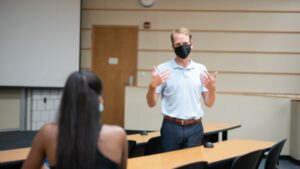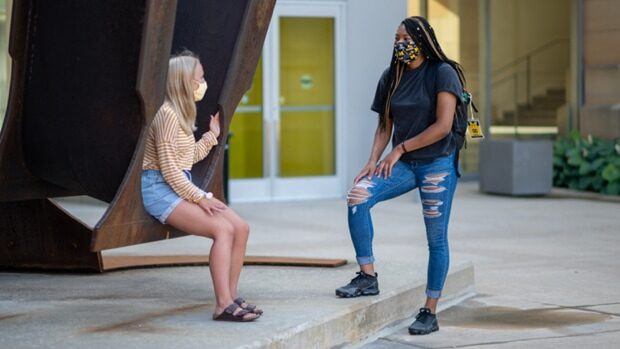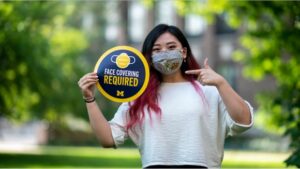Writing the manual
As we continue our extensive preparations for a fall semester that offers a mix of remote, in-person, and hybrid courses, I want to provide an update on several major developments.
We recognize that in many parts of the country and world, COVID-19 is spreading more widely than was the case at the time we announced our initial plan for a public health-informed hybrid residential semester. Also, access to testing, while greatly improved, is once again lagging behind demand, especially when it comes to turnaround time. We continue to monitor the state of the pandemic nationally and locally, and will modify our plans as conditions dictate.Many of you have asked questions and some of you have shared concerns about our plans. Provost Susan Collins and I appreciate your engagement with us during meetings and through email, and we’re continuing to update the FAQ section of the campus Maize and Blueprint site based on further questions and concerns that reach us. We’ve also heard some great ideas for moving forward.
Through it all, faculty and staff across the University are doing outstanding work in the face of great and unprecedented challenges. Each component of our mission – education, research, service, and patient care – has been enhanced by your determination and innovative spirit.
Implementing plans
We have less than a month before fall classes begin, and our schools, colleges and academic units are working to protect the health and safety of our community through the Provost’s Office’s Unit Reentry Planning. Part of this effort includes planning in the event that we must tighten or are able to relax safety measures.
Our Workplace Innovation & Staff Experience Committee is developing guidelines on how best to provide an innovative and safe workplace for U-M staff members, whether they are working remotely or working on-site, now and in the future.
At least 70 percent of credit hours for undergraduates are being taken fully remotely this fall among those currently registered, with many hybrid courses offering the option to attend remotely as well. This means that a number of students may choose to take their classes fully remotely and not come to Ann Arbor, and a significant majority of faculty teaching will be done remotely this fall.
We also know that our new international students need to take some in-person or hybrid classes because of federal guidelines and there are many others whose majors involve courses that can only be offered effectively in person.
We continue to require that everyone who can work from home do so. All campus units are finalizing plans for health and safety to protect faculty and staff who do need to be on campus. Everything we do to decrease on-campus density will make our campus spaces safer for those who are teaching or have to work on campus.
Here is where we are at on several additional key topics:
Pre-arrival COVID-19 testing for students living on campus
Undergraduate students moving into U-M Housing’s residence halls and apartments will be tested for the virus that causes COVID-19, and be cleared before arriving in Ann Arbor. U-M is partnering with the national testing company Quest Diagnostics to accomplish this. Quest will provide testing kits, at no additional cost to students and families, directly to on-campus housing students at their homes to self-administer and then mail back to Quest for analysis.
Students who fail to return a test will be tested immediately upon arrival and asked to practice enhanced social distancing until results come back. We are requiring all students, whether they live on campus or not, to practice enhanced social distancing for two weeks before returning to Ann Arbor.
Any students who test positive will be asked to delay arrival on campus. Current CDC guidelines call for asymptomatic persons who test positive to self-quarantine for 10 days. Students living in our Munger Graduate Residences had an earlier move-in, and they are being tested after arrival.
We are testing residence hall students because we are asking them to live with us, and they will be in new large-scale community housing environments immediately after arriving. This measure exceeds current CDC higher education guidelines, which call for testing of symptomatic individuals and those with recent exposures to someone with COVID-19.
Students not living in University housing will not undergo pre-arrival screening. They arrive here at different times, and many have been here most of the summer. Their living arrangements differ considerably. Because of these factors, we do not believe pre-arrival testing would be efficient or effective. As noted above, they will be required to adhere to enhanced social distancing for two weeks before class begins.One significant factor that influences our thinking on opening our residence halls and hosting a limited amount of in-person instruction is that surveys, as well as our experience last spring, indicate that a large fraction of our students will return to Ann Arbor to occupy their leased residences, be with their friends, and study remotely rather than stay at home around the state or country regardless of whether there is any in-person instruction. Therefore, overall risk of disease transmission in Ann Arbor might not be affected greatly were we to go fully remote, and many think that being linked to campus will result in improved adherence to public health guidance.
Enhanced social distancing prior to arrival
All U.S. students coming to Ann Arbor will be asked to practice enhanced social distancing during the 14 days before arriving on campus. During this 14-day period, students have been directed to monitor their health, reduce contact with others, and follow guidance consistent with recommendations from the Centers for Disease Control and Prevention. These include:
- Taking their temperature two times a day and monitoring for fever.
- Watching for cough, trouble breathing or additional COVID-19 symptoms.
- Staying home and avoiding contact with others outside of their homes, including not going to work, school or social gatherings.
- Avoiding public transportation, taxis or ride-shares.
- Maintaining a physical distance from others (about 6 feet).
- Wearing a face covering when in public settings or while interacting with others outside of the home.
- Seeking medical attention if they develop a fever, other symptoms, and/or test positive for COVID-19. They will then be asked not to come to campus until they receive further instructions.
For students arriving on campus directly from international locations, the 14 days of enhanced social distancing begins when they arrive, and can be done in the students’ residences. This may overlap with the start of classes, and students will be expected not to go to (in-person) class until the 14-day period is complete. Student Life has emphasized the importance of communicating with instructors directly to determine appropriate academic adjustments during this period.
We’ll also ask students to complete an online learning module that includes important information on COVID-19.
During the semester

Face masks will be required for in-person teaching on campus in Fall 2020. (Image: Michigan Photography.)
We are preparing to implement a carefully crafted response to how we handle suspected or positive cases of COVID-19. These measures include:
- We’ll offer testing for students when indicated through our University Health Service. Testing is offered for those who are symptomatic or who meet specific criteria. These tests will be performed through Michigan Medicine with a fast turnaround time to increase the effectiveness of contact tracing.
- We’ll continue to work closely with local public health officials to perform contact tracing for all infected students and employees as has occurred throughout the pandemic. We will use public health students trained and supervised by professionals to enhance our contact tracing capacity. These students will also get appropriate course credit for this clinical activity as part of their curricular requirements.
- We’ll support and provide living space and meal delivery for any student who develops symptoms or tests positive and needs to quarantine or isolate safely. Including rooms we have set aside on campus for quarantine and isolation and possible overflow needs off campus, we expect to have space for 600 students at a time. As we saw in the spring, students who live nearby may choose to quarantine or isolate at home. We expect only a small fraction of this number to be students who test positive for the virus, the majority being close contacts who are being quarantined for 14 days.
- We have created an online symptom checker tool so members of our community can check any symptoms daily. Many are already using it. We’re modifying the tool for students, and it will be available later this month. The tool automatically refers users to appropriate medical follow-up based on daily results.
- Our Division of Student Life worked closely with U-M students across campus this summer to develop the Wolverine Culture of Care – a commitment to keeping the U-M campus community as healthy and safe as possible.
- We are working on a plan to perform surveillance testing of students in residence halls.
- As is the case now, faculty and staff who are experiencing COVID-19 symptoms are referred to their primary care provider or Occupational Health Services.
Contact tracing
Responsibility for contact tracing is vested in the Washtenaw County Health Department, which delegates authority for U-M to our Environment, Health, and Safety (EHS) Department. EHS performs contact tracing for all U-M employees and students and has been doing so throughout the pandemic.
As noted above, in collaboration with the county and University Health Service, EHS is organizing and training a mix of professional contact tracers and professional students from our School of Public Health who will assist with student contact tracing. I commend those in the SPH community for stepping up and using their expertise.
Risk assessment
The work of the COVID-19 Campus Health Response Committee, chaired by Dr. Rob Ernst (executive director of the University Health Service), is underway, and this group is responsible for the timely tracking and parsing of information, coordinating key U-M offices, and providing expert advice and recommendations to University leaders. This is key for us as conditions change.
Additionally, I will say again that we’re continuing to monitor the spread of the coronavirus in Michigan and beyond and will be ready to adapt our plans as needed. Conditions change daily, and I’m thankful that we have continued access to experts in public health and safety who are deeply devoted to our community and will serve as a key resource as we make decisions moving forward.
Our public health advisory group has suggested a set of criteria we will use to determine whether spread of COVID-19 during the semester requires closure of a residence hall or other campus spaces or even a reversal of our plans and a transition to a fully remote semester. Data we will follow to arrive at these decisions include:
- Epidemiological measures of regional and campus disease activity.
- Assessment of both ambulatory clinical resources on campus and hospital and health system capacity.
- Availability of case investigation, contact tracing and quarantine space resources.
We are working with a group from our School of Public Health who are developing a campus- and Ann Arbor-specific model of COVID-19 spread that will allow us to predict the direction of the pandemic locally and model the effectiveness of potential interventions. This same group developed the model that is being used by Governor Whitmer and her team in managing the state’s response to the pandemic.
Faculty from SPH are conducting a study that is monitoring environmental contamination of the coronavirus in U-M spaces and evaluating the exposure risk. The researchers’ work seeks to add understanding around exposures in workplaces and educational and residential settings.
Learning as we work
As you know, our research enterprise has been reactivating for much of the summer. More than 7,000 University of Michigan researchers have resumed their important work. There is no indication of any virus transmission between laboratory or research coworkers at work, though there have been three positive COVID-19 cases among these approximately 7,000 faculty, students, and staff working in our labs this summer. EHS is performing the contact tracing, and the individuals who’ve tested positive are isolating.
Many of the measures we are putting in place for fall align with what we’ve done in our research labs and in Michigan Medicine facilities. We’re requiring face coverings on all campus property and transportation, controlling density, telling anyone who is sick to stay home, and promoting research-based health and safety practices.
All of this is possible because of your dedication to our University, colleagues, friends, loved ones, and students.
I thank you for your outstanding work and appreciate your passion for ensuring that our University is as safe as possible for all. We will continue to update you as conditions evolve as the semester approaches.
Sincerely,
President Mark S. Schlissel, MD, PhD






